
Serving South Central Texas Since 1999
What You Need to Know About Pests in La Grange, TX & Surrounding Areas
American Cockroach
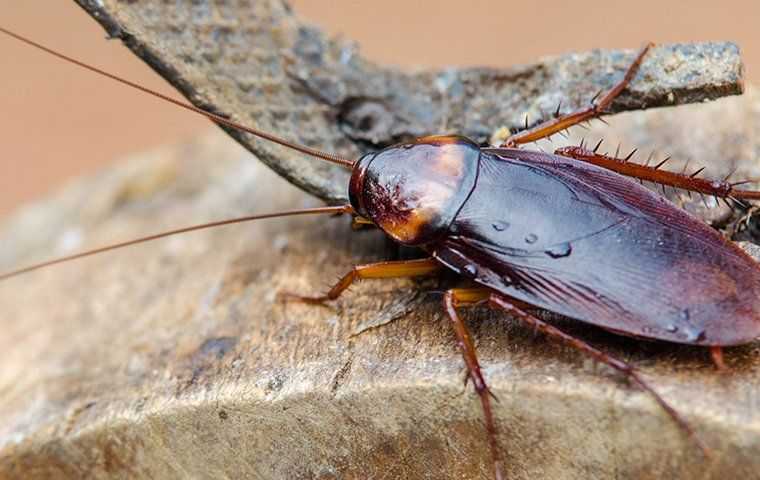
Scientific name: Periplaneta americana (Linnaeus)
Order: Blattaria
Description: This is one of the largest common cockroaches in Texas, reaching 1-1/2 to 2 inches. They are reddish-brown in color. The shield portion behind the head (prothorax) has a margin of light brown or yellow.
Another similarly-sized, black-brown, common indoor species is the oriental cockroach, Blatta orientalis Linnaeus, but it differs because the wings on adults are rudimentary on the female and only cover 75% of the abdomen of the male. Other cockroach species come in a variety of sizes and shapes. Most are dark brown with or without color patterns on the body. Occasionally, a whitish cockroach is observed incorrectly thought to be an "albino" form. These are, in fact, roaches that have just molted and have not yet had time to darken their "new" exoskeleton.
There is, however, a pale green cockroach species, the Cuban cockroach, Panchlora nivea (Linnaeus) (Blattodea:Blaberidae), that is occasionally encountered in the Houston area. Other common outdoor species include wood roaches, Parcoblatta spp. (Blatellidae) and the pale-bordered field cockroach, Pseudomops septentrionalis Hebard (Blattaria: Blattellidae).
Life Cycle: Simple metamorphosis (egg, nymph, adult). Female cockroaches glue or drop 1/4 inch long bean-like egg capsules (oothecae) containing about 15 eggs on or around infested areas. Nymphs hatch from the egg case that resemble small grayish-brown adult cockroaches without fully developed wings. Nymphs molt 10 to 13 times in over a year (470 to 600 days, depending on temperature) before becoming adults.
Habitat, Food Source(s), Damage: This is generally an outdoor species, living in wood piles, decaying trees, palm trees and in sewer systems. Cockroaches have flattened bodies that allow them to enter homes through cracks around loose-fitting doors and windows, and where electric lines or pipes pass through walls. They are mainly active at night and hide in cracks and crevices during the day, preferring dark moist sites in attics and basements. Cockroaches eat almost anything including meats and grease, starchy foods, sweets, baked goods, leather, wallpaper paste, book bindings and sizing. Adults are capable of gliding flights.
Pest Status: Although not shown to be direct carriers of disease, they can contaminate food and kitchen utensils with excrement and salivary secretions and leave an unpleasant odor.
German Cockroach
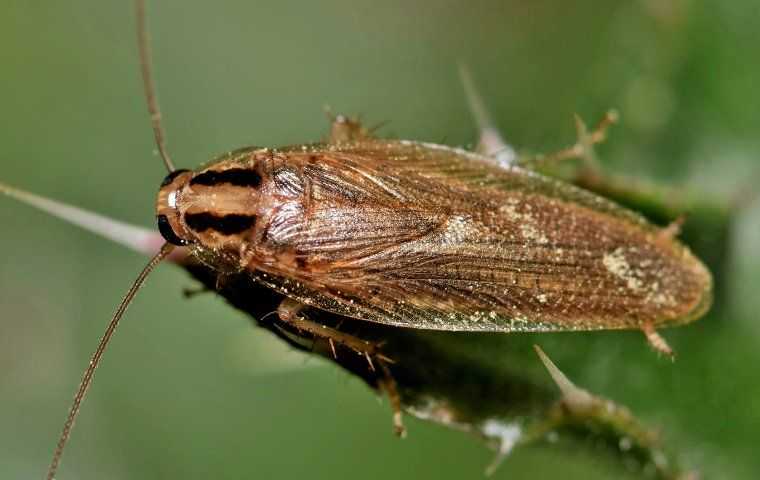
Scientific Name: Blattella germanica (Linnaeus)
Order: Blattaria
Description: The adult German cockroach is about 5/8 inch long, overall light brown in color and wings which cover the abdomen. The thoracic shield just behind the head (pronotum) is marked with two prominent black stripes. Immature stages (nymphs) are smaller, wingless and have a pale stripe (on at least the second and third thoracic segments in first stage nymphs) running lengthwise down the middle of the darker brown body.
The field cockroach, Blattella vaga Hebard, is similar to the German cockroach in appearance, but it occurs primarily outdoors where it feeds on decaying plant materials. Compared to the German cockroach, it is more active during daylight hours and will be found around lights. They also are known to fly when disturbed. The brownbanded cockroach, Supella longipalpa (Fabricius) is about the same size as the German cockroach, but appear " banded" because the wings are marked with a pale brown band at the base and another about a third of the distance from the base.
Life Cycle: Simple metamorphosis. Mated females produce an egg capsule that is attached to the end of the abdomen for up to a month before being dropped a day or so before eggs hatch. Each 5/16 inch long, brown egg capsule contains 30 to 40 eggs which hatch in 2 to 4 days after being deposited. Nymphs hatching from eggs are less than 1/8 inch long and wingless. They develop through 6 to 7 stages (instars) over 74 to 85 days (varying with temperature) before becoming adults. There may be four generations per year.
Habitat, Food Source(s), Damage: This is mainly an indoor species although they will also migrate outdoors from structure to structure. Occasionally, new infestations begin by bringing in cartons and other materials from infested structures that harbor the roaches or their eggs. Kitchens, bathrooms and other locations that provide food, moisture, warmth and shelter are preferred habitats. German cockroaches are mainly active at night, when they search for food and water. During the day, they remain concealed in cracks and crevices unless they are over-crowded, with all developmental stages occurring together. They also can occur in attics, wall voids, crawl spaces, foundation cracks, garbage areas and around the landscape. May spread food contaminants. Some people have allergic reactions to cockroaches or cockroach residues (e.g., feces, body extracts).
Pest Status: One of the most common household cockroach pests in the state; presence in homes is a nuisance and they may spread food contaminants. Some people have allergic reactions to cockroaches or cockroach residues (e.g., feces, body extracts).
Termites
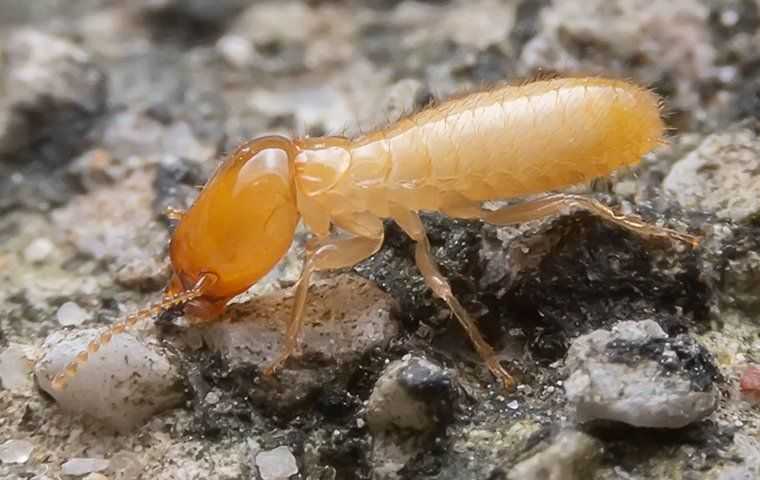
Scientific Name: Varies
Order: Isoptera
Description: Subterranean termites, Reticulitermes virginicus (in east Texas to Uvalde and Tom Green Counties) and R. hageni (in east Texas to Bexar and Eastland Counties), are social insects. There are three types (castes) of termite adults in a colony; 1) reproductives; 2) workers; and 3) soldiers. Reproductives can be winged, primary reproductives called alates or swarmers or wingless, secondary reproductives. Winged reproductives have 1/4 to 3/8 inch long pale yellow-brown to black bodies and bear four wings of equal size that may be smoky gray to brown and have few wing veins. Termite workers are white and soft bodied. Soldiers resemble worker termites, except that they have enlarged brownish heads and strong, well-developed jaws. Soldiers defend the colony from invaders, primarily ants.
The Formosan termite, Coptotermes formosanus Shiraki, found primarily in the greater Houston-Galveston area and Beaumont-Port Arthur, is another subterranean species. It is larger than the subterranean termite and has a pale yellow body color; the head shape of the soldier cast is more oval; and the wings of reproductives are hairy. Colonies, found in spaces such as wall voids or in hollows dug in wood both in or on the ground, are built of a mixture of chewed wood and soil cemented together, called carton. Reproductives swarm in late afternoon and evening, and are attracted to lights.
Drywood termites are light yellow to black with clear to smoky gray wings, about 7/16 inch long. Worker termites (nymphs), and are up to 3/8 inch long, wingless, white to grayish with white to yellowish-brown heads, and soldiers are similar but with large rectangular darker heads bearing well developed jaws (mandibles) used to defend the colony.
Termites are occasionally confused with winged ants (Hymenoptera: Formicidae): termites have body segments that are similar in width, hair-like (filiform) antennae and, when present, four wings of equal length; ants have narrow waists, elbowed antennae and forewings that are longer than hind wings. The differences between drywood termites (Kalotermitidae) and subterranean (Rhinotermitidae) are easiest to see in the venation of the wings of the adult reproductive caste. Wings of drywood termites have three heavy veins along the basal part of the front edge of the forewing and the crossveins near the wing tip are angled, making trapezoidal cells. Subterranean termite wings have just two major veins along the front edge of the forewing and the cross veins towards the wingtip are perpendicular to these veins, making square and rectangular cells. Soldier and worker castes are more difficult to distinguish, but are generally larger than subterranean termites. However, other characteristics of infested wood can be used for identification.
Life Cycle:
Subterranean termites: Simple metamorphosis. Subterranean termites nest in the soil. Winged male and female reproductives swarm from the nest in daylight during the spring, usually after a rain when proper conditions (heat, temperature and light) occur. Male (king) and female (queen) termites mate and seek a colony site and stay together because periodic mating is required for continuous egg production. Development from egg to adult takes 2 to 7 weeks. Eggs, produced by the queen develop into wingless nymphs that develop through three stages (instars), requiring 10-14 days, 2-3 weeks and 3-4 weeks, respectively. At first, only worker termites are produced. Thereafter, there can be three types of nymphs: 1) false workers or pseudergates with no wing pads that molt continuously; 2) nymphs with wing pads that develop into winged male and female reproductives; and 3) soldier nymphs. Reproductive termites can develop from nymphs with wing pads (primary reproductives) as well as from false worker nymphs (secondary nymphoid repro- ductives or tertiary ergatoid reproductives) in the absence of primary reproductives due to the death of the queen or colony fractionation. A termite colony matures in 2 to 4 years and may contain 21,000 to 365,000 termites.
Drywood termites: Simple metamorphosis. Winged male and female termites swarm and mate, usually in late summer and early fall. Males and females remain together to start a new colony and mate periodically thereafter to assure continued egg production. Eggs, produced by the mated female reproductive or queen, hatch in about two weeks. Nymphs develop through two stages (instars) and become workers (nymphs). Additional molts produce adults including soldiers, winged forms called alates or primary reproductives, and wingless forms (dealates, secondary reproductives) which are capable of replacing deceased primary reproductives in an existing colony. A colony requires several years to become mature, an event marked by the production of winged reproductives. Mature colonies may contain up to 10,000 individuals.
Habitat, Food Source(s), Damage:
Subterranean termites: Worker termites gather food, maintain the nest, and feed and care for other members of the colony. Paper, cotton, burlap and other plant products as well as the stems of some plants (e.g. okra) serve as food sources. Workers returning to the colony share food with the rest of the colony. Workers feeding above ground construct tunnels or tubes made of soil and wood particles and salivary secretions. These tubes protect the workers and retain moisture in the nest.
Drywood termites: Colonies of this social insect occur in sound, dry wood. Swarming occurs at dusk or early evening and the swarmers are attracted to lights. The mated pair starting a colony seeks a crack and crevice in wood, such as the spaces between wood shingles. The queen and male (king) produce and tend the first brood. Afterwards, worker termite’s care for the queen and male, tend the brood (eggs and immature forms), gather food, build and maintain the colony. Termite workers eat cellulose-containing materials found in plant products, which is digested by a one-celled animal (Protozoan) living in their digestive system. Workers share food with the other members of the colony. Tunnels or galleries which house the colony are produced by workers in dry, cured wood are clean and free of debris. Tunnels can run across the grain of the wood. Those reaching the wood surface end in "kick" holes, where unique fecal pellets are expelled from the colony and pile up below infested timbers. These pellets are hard, 1/25 inch long, elongated seed-like particles with six lengthwise ridges between depressed surfaces. Soldier termites defend the colony from intruders.
Pest Status:
Subterranean termites: Worker termites tunnel into structural timbers and other sources of cellulose on which they feed. Termites are harmless to man and animals although soldier termites can bite. They occur throughout Texas, but are more prevalent in coastal regions.
Drywood termites: Termites occur in Texas coastal counties, with western spot infestations in Uvalde and San Antonio and north to Collin County, causing a great deal of concern to homeowners when discovered. Biology differs from the more common subterranean termite because it does not nest in the ground and thus requires a different, more expensive treatment approach. Termites are medically harmless.
Striped Bark Scorpions
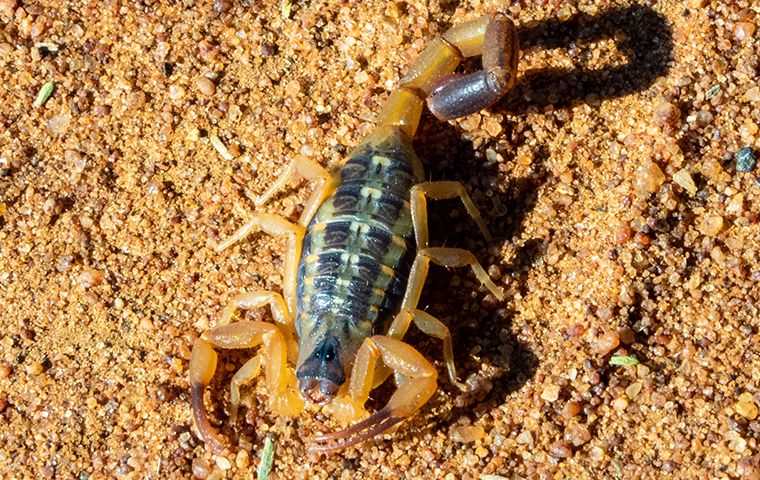
Scientific Name: Centruoides vittatus (Say)
Order: Scorpionida
Description: Scorpions are non-insect arthropods. Adults average about 2-3/8 inches (60 mm) in length, with the tail being longer in the males than in the females. Body color of adults varies from yellowish to tan, marked with two broad, blackish stripes on the upper surface of the abdomen. Populations in the Big Bend area may be only faintly marked or completely pale. There is a dark triangular mark on the front (anterior) portion of the head region (carapace) in the area over the (median and lateral) eyes. Younger specimens may be overall lighter in color, and basis of the pedipalps and the last segment of the body (postabdomen) is dark brown to black. The key recognition characters for this species are the slender pedipalps and the long slender tail.
Life Cycle: Scorpions are capable of reducing their metabolic rates to very low levels. Mating apparently takes place in the fall, spring and early summer. All scorpions are born live (viviparous), and embryos are nourished in the female’s body (in utero or via a “placental” connection). Development (gestation) is estimated to take about 8 months, but varies depending on the species. Young are born in litter sizes from 13 to 47, averaging about 31. The young climb to the mother’s back after birth and soon molt. After the first molt they disperse to lead independent lives. Immature scorpions molt an average of six times before maturity. Some species may live for 20 to 25 years but the typical scorpion probably lives between three and eight years. Adults may produce several broods.
Habitat, Food Source(s), Damage: Scorpions use the pincers to capture and hold prey. This species occurs under rocks, under boards, and in debris. It can be found indoors or outdoors in a wide variety of habitats (pine forests in East Texas, rocky slopes, grasslands, juniper breaks in other parts of the state). Centruroides are active foragers and do not burrow. They are considered “bark scorpions” with a distinct association with dead vegetation, fallen logs, and human dwellings. It is common for them to climb, and many reports in homes are associated with attics. Scorpions remain sheltered in the daytime and become active at night. This behavior helps with regulating temperature (thermoregulation) and water balance. Their bodies are covered with a waxy cuticle which also helps reduce water loss. For reasons yet unknown, the scorpion cuticle fluoresces under ultraviolet light i.e., a blacklight.
Pest Status: Most common and widespread scorpion in Texas; stings are painful and produce local swelling and itching that may persist for several days. Reaction to the bite may vary based on sensitivity of the individual. Non-lethal stings may be mild to strong and produce edema (swelling), discoloration, numbness, and pain which may last for several minutes to several days. Deaths attributed to this species are not well substantiated. There are no scorpions in Texas that are considered lethal to man.
Texas Leafcutting Ant
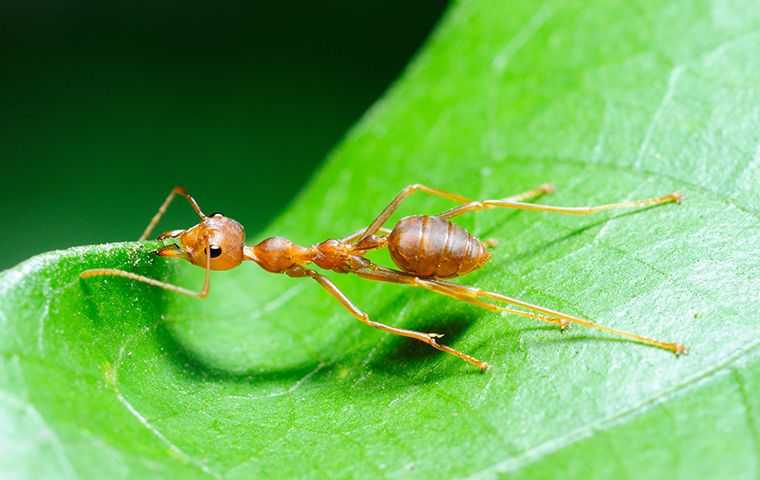
Scientific Name: Atta texana (Buckley)
Order: Hymenoptera
Description: Also known as town ants, cut ants, parasol ants, fungus ants or night ants. Sterile female worker ants are rust brown, 1/16 to 1/2 inch long and have three prominent pairs of spines on the thorax. The queen is much larger with the body being about 3/4 inch long. Damage to plants produced by Texas leaf cutting ants can resemble damage produced by some other chewing insects such as leaf cutting bees. However, ants and characteristic ant mounds around damaged plants should help determine the cause. Several other Texas ants produce mounds, including the red imported fire ant. The only other large ant that produces colony entrances with a central opening surrounded by course soil is the red harvester ant, Pogonomyrmex barbatus Smith. However, the red harvester ants do not have spines on the thorax and usually only gather seeds.
Life Cycle: Leaf cutting ants are social insects. Queen ants deposit eggs that hatch into cream colored larvae. Fully developed 1/4 to ½ inch long larvae form pupae. In the spring, some larvae develop into larger (3/4 inch long) winged male and female ants, called reproductives. Males have much smaller heads than do females and both have long smoky black wings. Sometime between April and June, on clear moonless nights, and usually after heavy rains, these winged ants leave the colony on mating flights. These ants are attracted to porch lights and are some of the largest ants encountered in Texas. Virgin queens carry a small piece of the fungus from their parent colony in a small cavity inside their mouths. After mating, the males die. The queen loses her wings and digs a small tunnel or gallery in which they begin laying eggs and culturing her fungus garden on her feces. The queen feeds largely on her own eggs until small worker ants develop from the surviving eggs and begin to collect foliage on which to culture the fungus. Colonies can survive for many years and colonies may contain over 2 million ants. The nest interior may be 15 to 20 ft. deep and contain numerous chambers interconnected by tunnels.
Habitat, Food Source(s), Damage: Mouthparts are for chewing. Worker ants remove leaves and buds from weeds, small grains, forage and turf grasses, fruit and nut trees including plum and peach trees, blackberry bushes, and many ornamental plants. Pine trees and pine seedlings may also be damaged when other plant material is scarce. Defoliation is particularly noticeable during winter months. Worker ants forage when temperatures range from 45 to 80 degrees F during the year, but mainly at night during the summer. Worker ants travel up to 600 ft. or more along foraging trails and dismantle foliage into leaf pieces that they carry back to the colony over their bodies. In the colony the pieces of leaves are used to raise a fungus. All members of the colony feed exclusively on the fungus.
Pest Status: Worker ants bite; primarily a pest of plants because they remove leaves for growing fungi; large underground colonies marked on the surface by the presence of many 5 to 14 inch tall, 1 to 1-1/2 ft. diameter mounds made of course particles of sandy soils and with single central openings; around colonies, foliage can be stripped from plants in an area over an acre; more commonly encountered in deep, well drained sandy or loamy soils; large colonies can excavate soil from underneath roadways, causing a structural threat.
Bed Bugs
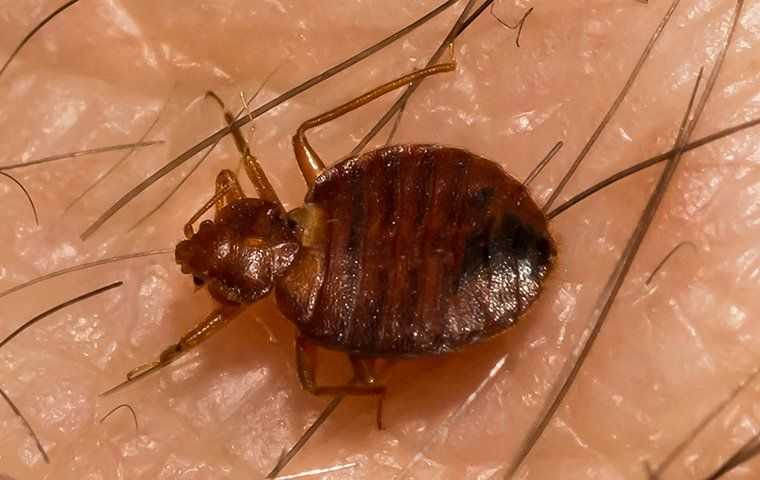
Scientific name: Cimex lectularius Linnaeus
Order: Hemiptera
Description: Sometimes referred to as red coats, chinches, or mahogany flats, bed bugs, Cimex lectularius Linnaeus, are blood feeding parasites of humans, chickens, bats and occasionally domesticated animals. Bed bugs are suspected carriers of leprosy, oriental sore, Q-fever, and brucellosis but have never been implicated in the spread of disease to humans. After the development and use of modern insecticides, such as DDT, bed bug infestations have virtually disappeared. However, since 1995, home pest control professionals have noticed an increase in bed bug related complaints.
The adult bed bug is a broadly flattened, ovoid, insect with greatly reduced wings. The reduced fore wings, or hemelytra, are broader than they are long, with a somewhat rectangular appearance. The sides of the pronotum are covered with short, stiff hairs. Before feeding, bed bugs are usually brown in color and range from 6 to 9.5 mm in length. After feeding, the body is often swollen and red in color.
The two bed bugs most important to man are the common bed bug, Cimex lectularius, and the tropical bed bug, Cimex hemipterus. These two species of bed bugs can easily be distinguished by looking at the prothorax, the first segment of the thorax. The prothorax of the common bed bug is more expanded laterally and the extreme margins are more flattened than that of the tropical bed bug.
Life Cycle: Because of their confined living spaces, copulation among male and female bed bugs is difficult. The female possesses a secondary copulatory aperture, Ribaga's organ or paragenital sinus, on the fourth abdominal sternum where spermatozoa from the male are injected. The spermatozoa then migrate to the ovaries by passing through the haemocoel, or body cavity. The female bed bug lays approximately 200 eggs during her life span at a rate of one to 12 eggs per day. The eggs are laid on rough surfaces and coated with a transparent cement to adhere them to the substrate. Within six to 17 days bed bug nymphs, almost devoid of color, emerge from the eggs. After five molts, which takes approximately ten weeks, the nymphs reach maturity.
Habitat, Food Source(s), Damage: Human dwellings, birds’ nests, and bat caves make the most suitable habitats for bed bugs since they offer warmth, areas to hide, and most importantly hosts on which to feed. Bed bugs are not evenly distributed throughout the environment but are instead concentrated in harborages. Within human dwellings, harborages include cracks and crevices in walls, furniture, behind wallpaper and wood paneling, or under carpeting. Bed bugs are usually only active during night but will feed during the day when hungry. Bed bugs can be transported on clothing, in traveler's luggage, or in bedding and furniture but lack appendages to enable them to cling to hair, fur, or feathers, so are rarely found on hosts.
Pest Status: Bed bugs are most active at night, they are extremely shy and wary so their infestations are not easily located. However, when bed bugs are numerous, a foul odor from oily secretions can easily be detected. Other recognizable signs of a bed bug infestation include excrement left around points of entry and exit to their hiding places and reddish brown spots on mattresses and furniture. Good sanitation is the first step to controlling the spread of bed bugs. However, upscale hotels and private homes have recently noted infestations, suggesting that good sanitation is not enough to stop a bed bug infestation.
Mosquitoes
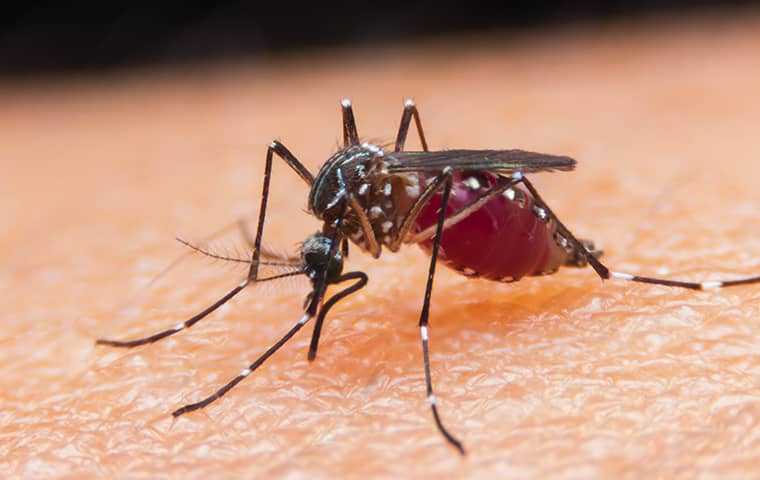
Scientific Name: Various species within the Culicidae family
Order: Diptera
Description: Mosquitoes are small, flying insects with slender bodies and long, thin legs. They have two wings and a characteristic long proboscis (mouthpart) for feeding on the blood of hosts. Female mosquitoes require a blood meal for egg development, while males primarily feed on nectar. Mosquitoes are known for their distinctive high-pitched buzzing sound.
Life Cycle: Mosquitoes undergo complete metamorphosis. The life cycle consists of four stages: egg, larva, pupa, and adult. Eggs are laid in standing water, and the larvae and pupae also develop in water. The time it takes to complete the life cycle varies by species and environmental conditions.
Habitat Food Source(s), Damage: Mosquitoes breed in various water sources, ranging from stagnant ponds and marshes to artificial containers like buckets, tires, or flowerpots. They are most active during warm and humid conditions. Female mosquitoes feed on the blood of hosts, including humans and animals, to obtain the necessary proteins for egg development. Male mosquitoes primarily feed on nectar from flowers. Mosquitoes are vectors of various diseases, including malaria, dengue fever, Zika virus, West Nile virus, and others. Their bites can cause itching and discomfort. Additionally, mosquitoes are considered nuisances due to their presence and their potential to transmit diseases.
Pest Status: Apart from their role as disease vectors, mosquitoes inflict bites that, while generally causing itching and discomfort, can lead to more severe allergic reactions in some individuals. Their prevalence also contributes to the nuisance factor, disrupting outdoor activities and affecting the overall quality of life. Mosquito control measures, ranging from habitat modification to the use of insecticides and biological control methods, are crucial to managing mosquito populations.
Rodents
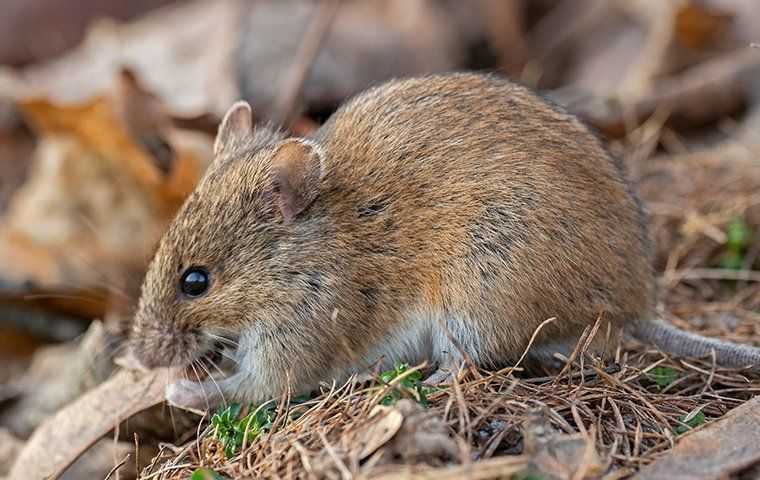
Common Name: Rodents
Scientific Name: Various species within the order Rodentia
Order: Rodentia
Description: Rodents are mammals characterized by continuously growing incisors that they must gnaw on to prevent overgrowth. They have a diverse range of sizes and appearances. Common rodents include mice, rats, squirrels, and beavers. They have sharp, chisel-like incisors, a well-developed sense of smell, and are often characterized by a rapid reproductive rate.
Life Cycle: Rodents typically have a short gestation period, and their offspring are born in a relatively undeveloped state. They undergo rapid development and reach sexual maturity at a young age. The life span of rodents varies among species.
Habitat, Food Source(s), Damage: Rodents can adapt to various environments, including urban, suburban, and rural areas. They often nest in burrows, nests, or structures such as attics and wall voids. Their ability to thrive in different habitats contributes to their widespread distribution. Rodents are opportunistic feeders and consume a variety of foods, including grains, seeds, fruits, insects, and human food. Some species, like rats, are known to gnaw on non-food materials to keep their incisors from overgrowing. Rodents can cause damage to structures by gnawing on wood, wires, and insulation. They are known carriers of diseases and can contaminate food and living spaces with their droppings and urine. Rodents may also damage crops in agricultural settings.
Pest Status: Rodents are unequivocally common pests with the potential to cause widespread damage to property and pose serious health risks. Their adaptability, rapid reproduction, and capacity to contaminate environments underscore the urgency of effective control strategies to mitigate the impact of rodent infestations. Proactive measures, including habitat modification, proper waste management, and professional pest control services, are crucial in preventing and managing rodent-related issues.

Hear From Our Happy Customers
At Double C Pest Control, your satisfaction is our priority! See for yourself what our customers have to say about working with us.
-
"This team deserves all the stars!"Double C Pest Control truly cares! They go above and beyond to explain the process clearly. I receive text messages when they're on the way and a phone call when it's done. This team deserves all the stars!Scott & Angela M.
-
"I highly appreciate the attention to detail."Very professional! A site visit identified my ant problem, and the team returned the same week to provide service. The follow-up included details on all pesticides used with attached info on each. I highly appreciate the attention to detail. Highly recommended!Kyra D.
-
"Fantastic Job!"Cody with Double C Pest Control did a fantastic job servicing my home.Charles D.
-
"Great Job!"Great job and communicated with us clearly about what was found in the WD Inspection.Jason L.
-
"Very Professional!"Gabby came out quickly after we called and did a professional and thorough examination of rodent problem that seems to have exploded this year.Cissie M.
-
"10/10 Service!"10/10 was recommended by a family member who used them and they were recommended by someone as well.Lexa J.
-
"Great Customer Service!"We had a huge flea infestation in the house we recently bought so we called Double C.Alizon A.




